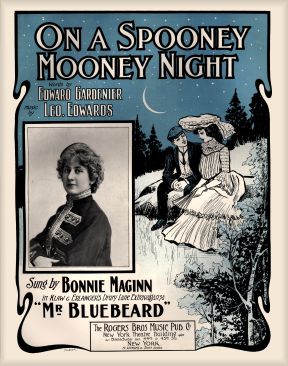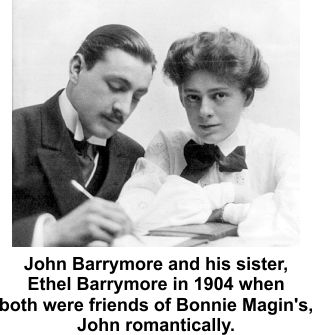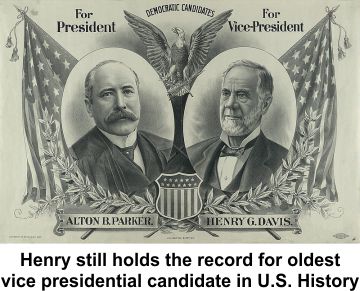|
Bonnie Magin (1880–1964) was the
daughter of Chicago board of trade member John R. Magin
(1848–1910)▼1
and Margaret Anna Sullivan Magin (1849–1920). It was not common for
a girl from the middle class to become a theater
entertainer but Bonnie did so at age sixteen.
The story went that she was with her mother, waiting backstage for a
friend at Chicago's
Schiller Theater in June 1896.
Mikado producer David Henderson
(1853–)▼2
mistook her for a chorus applicant. The pretty
teenager rejected a position in the chorus and
cheekily said she'd consider joining the company as
a dancer. She gave an impromptu demonstration
of her dancing skills and her nine-year career as a dancer and
singer began two days later.
She went on the road with Henderson's company for a
few months but when it failed she joined Weber and Fields,
the vaudeville company with which she would be most associated
throughout her life, but for a sojourn with Klaw &
Erlanger that began with a fit of temper in 1902.
Bonnie takes a stand
As a twenty-two-year-old earning $100 per week
($3,000 today), she flounced away from W&F in the
summer of 1902. See article at right. Her pique may have been
aroused by an article appearing in a Brooklyn
newspaper that April that described Bonnie as
co-heading the "Weberfield chorus" with Belle Robinson
in their performance of John Stromberg's charming
"coon" songs, choreographed by John Mitchell.
While Bonnie's opinion of chorus girls had likely
improved over the prior six years, she aspired to
become a musical comedy star such as
Fay Templeton and felt remaining with W&F made
that unlikely.
Mr. Bluebeard
Four months later, in Dec 1902,
she was in New York, rehearsing for Klaw & Erlanger's
upcoming Drury Lane extravaganza, Mr. Bluebeard,
scheduled to open Jan 21, 1903, at the Knickerbocker Theater
in New York. Bonnie had been cast in the role of Imer Dasher, manager of Bluebeard's palace in
Baghdad (though in a pre-opening newspaper story it was
reported she'd be playing the role of the prettiest
of Bluebeard's wives, Phoebe). I suspect it
was her first important speaking role. Baghdad scenes
appeared only in Act I but Bonnie also sang in Acts
II and III.▼3 One newspaper reviewer described Bonnie's role as dominant in the production.
In Bluebeard Bonnie danced with Dan McAvoy in New York and Harry Gilfoil
on the road, along with the
Pony Ballet, singing in at least four tunes (see
below).

One newspaper reviewer described Bonnie's performance in
Mr. Bluebeard as "satisfactory." His opinion of other cast
members worse: "Flora Parker as Fatima is poor
and sings weakly." "Joe Cawthorne is disappointing
as Irish Patshaw."
Newspapers did not report anything about Bonnie's escape from the
Iroquois Theater except that she was in her dressing
room when it started and had to flee wearing
stockings but without shoes. When authorities
allowed cast members to look for their clothing
amongst items removed from the dressing rooms,
Bonnie was one of the few who suffered no loss.
Despite the door to her dressing room being burned
away, flames did not touch her jewelry, purse, trunk
or muff.
From Bonnie's perspective, she escaped from the Iroquois with her
life and from Mr. Bluebeard with a successful debut as a singer and performer capable
of carrying a feature role. She went on from
Mr. Bluebeard to The Office Boy and in 1904 returned
to Weber & Fields where she remained for the balance
of her career. Of her performance in Mr.
Bluebeard at the Alvin Theater in Pittsburgh in
September 1903, the theater reviewer wrote,
"Bonnie Maginn comes pretty near being the whole
show, from the feminine side of the question. She is
fair to look upon, sings well, dances gracefully and
all with a vivaciousness that seems real."
Press rancor washed away by passing time
During the early years of Bonnie's career, the press
directed rather many sneers in her direction. She
was fat-shamed and ridiculed for her ambition.
Reporters made mention of the volume of photos of her
that appeared in newspapers, even noting that her picture appearing on a
tobacco card. When she demonstrated that she
could sing as well as dance, they gave credit
begrudgingly. Was the negativity born of
loyalty to Webber & Fields who sometimes made her the butt of
jokes in their act after she left their company?
Did she have an abrasive personality? Did the
perky self-confidence that got her into the business in the
first place become excessive? Was Bonnie resented for being
more skilled than some at self-promotion? Was
there jealousy because her wealthy paramour (see
below) could afford more photo portrait sessions
than could other ingénues?
|

|
Bonnie gets a history bump
Whatever the cause for stigma within her trade in the early
1900s, by the 1930s newspapers forgot her weight and
remembered her shapely legs. Some of what appeared
as a change of heart may have been logistics and
editing. More photos of Magin were available
and in terms of photographic quality and creative
appeal, they were more appealing than most, so
newspapers and magazines used them in nostalgia
pieces. To support the pictures they then
inserted Magin's name in the copy alongside stars
such as Lillian Russell and Fay Templeton.
Bonnie's photos that had annoyed reporters decades
earlier elevated her to the level of performers with
much longer and more celebrated careers.
Romance
"Bonnie Maginn was never a principal but always a star. She had
that in the warm Irish heart of hers which drew men to her."
Fredrick Collins, "The Loves of John Barrymore," Liberty
Magazine Sep 1936
One of the men drawn to Bonnie was
John Barrymore,
brother of her friend,
Ethel Barrymore (1879-1959). It was said that
 Bonnie and John had an easy camaraderie
but Barrymore eventually fell for Vivian Blackburn and Bonnie for
multimillionaire, John T. Davis (1874-1935). Bonnie and John had an easy camaraderie
but Barrymore eventually fell for Vivian Blackburn and Bonnie for
multimillionaire, John T. Davis (1874-1935).
In early 1906 Bonnie took a leave of absence from the
stage to spend six months traveling in the west with
Davis, her boyfriend of several years. It made a
sensation because Davis's father, an eighty-year-old
former U.S. Senator from West Virginia, was a
Democratic vice-presidential candidate
 with
Alton B. Parker, the election four months away.
Henry Gassaway Davis had amassed a fortune in
coal mining and railroad investments. Son John, as
manager of his father's investments, was wealthy in his own right. with
Alton B. Parker, the election four months away.
Henry Gassaway Davis had amassed a fortune in
coal mining and railroad investments. Son John, as
manager of his father's investments, was wealthy in his own right.
Davis's wife had filed for a divorce, naming Bonnie
as co-respondent. Newspapers reported he had spent a
great deal of money on gifts for Bonnie and in trying to
raise her from the chorus to stardom. It was
predicted that the couple would marry if he could
divorce his wife.
Eighteen years later Bonnie sued Davis for breach of
promise. In her complaint, Bonnie asserted he had
made numerous marriage proposals 1903-1913 then
changed his mind. In exchange for her releasing him
from his marital promises he agreed to pay her $300
per month for the rest of her life. He made the
payments until 1922. According to Bonnie's tally,
he was $5,400 in arrears. Reading between the lines
it sounds like Bonnie had become the other woman,
possibly his mistress, in a very old and predictable
story in which he spent years promising to leave his
wife and marry Bonnie. Perhaps somewhere over
the years his payments began to feel like blackmail.
In the 1920 U.S. Census, John's marital status is
described as divorced but I found no
documentation to support it and at his death in 1935
his obituary listed his widow as a survivor. The story
of Bonnie's lawsuit appeared in dozens of
newspapers in June 1924 then disappeared. A
settlement seems likely. Henry had co-founded
Davis & Elkins College who in 1937 named a football
practice field after John. The school
still exists, its field name probably long forgotten.
Bonnie's ending
A helpful fellow connected with
Friends of Maple Grove
Cemetery in Kew Gardens, New York reports that Bonnie is buried there with her parents
and one of her sisters, Vernie, without a grave marker.
On file is a rather sad letter from Bonnie. It
accompanied a payment for maintenance on the plot
and expressed her hope of having enough money to
erect a grave marker. The
diligent group there hopes to erect a stone in the
future.
|
